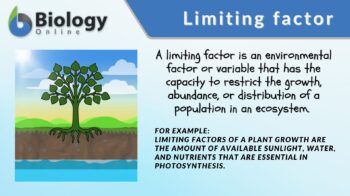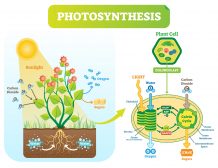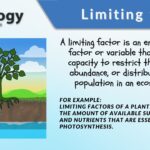
Limiting factor
n., plural: limiting factors
[ˈlɪmɪtɪŋ ˈfæk.tɚ]
Definition: any of the factors or variables capable of limiting a process
Table of Contents
Limiting Factor Definition
A limiting factor refers to any of the factors (variables) in an environment capable of limiting a process, such as the growth, abundance, or distribution of a population of organisms in an ecosystem. Limiting factors may be density-dependent or density-independent. Those that are density-dependent tend to limit the growth, abundance, or distribution of a population depending on how dense a population is. Conversely, a density-independent limiting factor is capable of limiting population growth, abundance, or distribution irrespective of population density.
Limiting factors may also be single-limiting, i.e. when only one factor limits the system. When a factor causes an indirect restrictive effect or increases the effect of a direct limiting factor, it is termed a co-limiting factor. Examples of limiting factors that could limit the size of a population are food, nutrients, shelter, and mate. These resources are limited in the ecosystem, and as a result, they could drive living things to compete for them.
The principles or laws that help explicate limiting factors in an ecosystem are Liebig’s law of the minimum, Blackman’s law of limiting factor, and Shelford’s law of tolerance.
- In the law of minimum, the growth of population could be regulated by the scarcest resource, not by the resources in abundance.
- In the law of limiting factor, a biological or an ecological process that depends on multiple factors will tend to have a rate limited by the slowest factor.
- In the law of tolerance, the survival success of an organism is suggested to depend on a complex set of environmental factors.
A limiting factor is an environmental factor or variable that has the capacity to restrict the growth, abundance, or distribution of a population in an ecosystem. These factors are present in limited supply. Thus, organisms tend to compete for their limited availability in the ecosystem. Different limiting factors affect the ecosystem. They are (1) keystone species, (2) predators, (3) energy, (4) available space, and (5) food supply.
Etymology:
The term limiting factor comes from Latin limitare, meaning “to bound” and from Latin factor, meaning “a doer”, “performer”), from factus, meaning “done” or “made”.
Synonyms:
limiting resource; ecological factor; constraining factor
Watch this vid to know about limiting factors:
Principles and laws
The principle of limiting factors is defined as the principle whereby a factor that is in the shortest supply will limit the growth and development of an organism or a community. (1) Liebig’s law of the minimum, Blackman’s law of limiting factor, and Shelford’s law of tolerance are the laws that explain the principles of limiting factors.
Liebig’s law of the minimum
The Law of the minimum was originally developed by Carl Sprengel and then later popularized by Justus von Liebig. This law states that the growth is regulated by a limiting factor, i.e. the scarcest resource, rather than by the total resources available.
In biology and ecology, this means that the growth of a population is restricted by the factors that are scarcest and not by the factors that are abundant. This was based on the observation of crop growth. Accordingly, the addition of nutrients in abundance did not result in increased growth. Conversely, the addition of nutrients that are scarce, which in this case is the limiting factor, did lead to increased crop growth. This means that even if some of the nutrients in the soil are abundant but if the other nutrients are limiting or relatively fewer then crop growth will not increase.
Applying this principle to other biological populations, this implicates growth occurring only as dictated by the most limiting factor. This principle was used by William Cumming Rose as a basis for identifying the amino acids that were labeled as essential. (2)
Blackman’s law of limiting factor
The law of limiting factor was proposed in 1905 by the British plant physiologist, Frederick Frost Blackman. According to this law, a process that depends on multiple factors will have a rate limited by the pace of the slowest factor.
Photosynthesis, for example, is a biological process that depends on multiple factors. The general chemical reaction of photosynthesis is 6CO2+12H2O+energy=C6H12O6+6O2+6H2O. Based on this equation, CO2, H2O, and light energy (sunlight) are the limiting factors of this reaction. If any of them become accessible at a pace slower or lower than usual, the rate of photosynthesis is expected to become slow based on the pace of the slowest factor.
For example, if CO2 concentration becomes scarce (e.g. due to closure of stomatal openings in response to elevated temperatures in the environment), the rate of photosynthesis becomes slow even if H2O and light energy levels are amply available.
The same result will occur if light energy becomes less available or less intense, the rate of photosynthesis will be slower despite the abundance of CO2 and H2O. Light becomes a limiting factor in photosynthesis when the plant is unable to collect light, for instance, due to shade resulting from the dense population of plants.
Shelford’s law of tolerance
The law of tolerance was developed in 1913 by American zoologist Victor Ernest Shelford. It states that the success of an organism depends on a complex set of environmental conditions (environmental factors). And that organism would have the definite minimum, maximum, and optimum environmental factors that determine success. (3) These signify the limit of tolerance of that organism. However, the tolerance ranges may vary within the same organism, for example depending on the life stage (larval vs. adult).
Types of Limiting Factors
Density-dependent limiting factor definition
Density-dependent limiting factor refers to the factor restricting the size of a population based on density. A large, dense population is more strongly affected than a small or less dense population. For example, a dense population would have higher demands for food and water compared to a small population. In this case, food and water supply is the limiting factor and it depends on density. Disease as a factor is also density-dependent. It spreads faster in dense populations than in small ones.
Density-independent limiting factor definition
Density-independent limiting factor refers to the limiting factor that is not dependent on density. The limiting factor can restrict population size independent of how dense the population is. For example, a catastrophic event, such as an earthquake or a volcanic eruption, could cause a population decline regardless of population density.
Single-limiting and co-limiting
A single-limiting factor is when there is one factor that limits the system. A co-limiting factor is when a factor affects the population of organisms in an ecosystem indirectly but increases the limitation of the factor directly affecting the population.
Limiting Factors Examples
In the law of the size of a population, a population will grow exponentially as long as the environment to which all individuals in that population are exposed remains constant. (4) Thus, if the environmental conditions are kept the same, the population is expected to grow. However, there will come a time when the population will reach the maximum at which the environment can sustain. This is called the carrying capacity, the maximum load of the environment.
Carrying capacity is the number of individuals that an environment can sustain without ending in damage or destruction to the organisms and the environment. Thus, population size may increase until carrying capacity is met. Above this capacity, the population size will eventually decrease. The determiners of carrying capacity are limiting factors. The common limiting factors in an ecosystem are food, water, habitat, and mate. The availability of these factors will affect the carrying capacity of an environment.
As the population increases, food demand increases as well. Since food is a limited resource, organisms will begin competing for it. The same thing goes for space, nutrients, and mates. Since these resources are available for a limited amount over a given period of time, inhabitants of a particular ecosystem will compete, possibly against the same species (intraspecific competition) or against other groups of species (interspecific competition). (5)
In the wild, another predominant symbiosis is the predator-and-prey relationship. The deer populations, for instance, could decline if predation is high. If the number of wolves is relatively greater than the number of deer as their prey, the number of deer could drop. However, with the dwindling number of deer, the number of wolves could also eventually decline. This predator-prey factor is an example of a biotic factor in an ecosystem.
While a biotic factor includes the activities of a living component of an ecosystem, an abiotic factor includes the various physicochemical factors in an ecosystem. These physicochemical factors include sunlight, humidity, temperature, atmosphere, soil, the geology of the land, and water resources. Temperature, for instance, is a major limiting factor primarily due to the fact it affects the effectiveness of enzymes and catalysts, which are essential in an efficient system, both biological and chemical.
Answer the quiz below to check what you have learned so far about limiting factors.
References
- Principle of limiting factors – Oxford Reference. (2017, June 16). Retrieved from Oxfordreference.com website: https://www.oxfordreference.com/view/10.1093/oi/authority.20110803100346211
- Rose, W.C. (1931). Feeding Experiments. Journal of Biological Chemistry 94: 155–65.
- Shelford, V. E. (July 1, 1931). “Some Concepts of Bioecology”. Ecology. 12 (3): 455–467. doi:10.2307/1928991.
- Turchin, P. (2001). “Does Population Ecology Have General Laws?”. Oikos. 94 (1): 17-26. doi:10.1034/j.1600-0706.2001.11310.x.
- Competition. (2019). Retrieved from Marietta.edu website: http://w3.marietta.edu/~biol/biomes/competition.htm
© Biology Online. Content provided and moderated by Biology Online Editors



